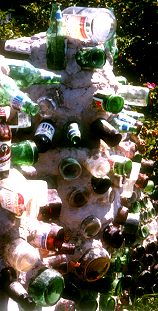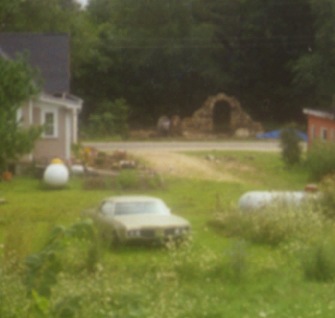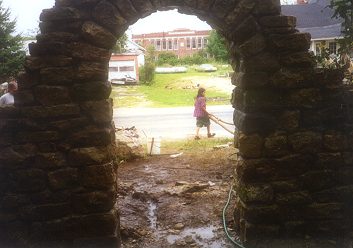 August 2025-- A methane-powered tour bus pulls up in front of the West Lima Post Office, just as a pack of cyclists arrives, still breathing hard from the long uphill ride from the train station at Richland Center to West Lima. Some of the visitors drift over to the Dreamtime Cafe for bioregional snacks and gotu kola tea, others browse through the craft shops but most wander about the Dreamtime Grotto Gardens. Especially for those who have never been here before, the experience is overwhelming: a phantasmagoria of plants, text, stones, colored glass, animals, running water, soundsäone of the great sacred sites of the former United States, a postrevolutionary tourist attraction that draws visitors from around the world. Old Dreamtimers still remember when the grotto was nothing more that a few bags of cement mix and some boxes of wine bottles and broken crockery....
August 2025-- A methane-powered tour bus pulls up in front of the West Lima Post Office, just as a pack of cyclists arrives, still breathing hard from the long uphill ride from the train station at Richland Center to West Lima. Some of the visitors drift over to the Dreamtime Cafe for bioregional snacks and gotu kola tea, others browse through the craft shops but most wander about the Dreamtime Grotto Gardens. Especially for those who have never been here before, the experience is overwhelming: a phantasmagoria of plants, text, stones, colored glass, animals, running water, soundsäone of the great sacred sites of the former United States, a postrevolutionary tourist attraction that draws visitors from around the world. Old Dreamtimers still remember when the grotto was nothing more that a few bags of cement mix and some boxes of wine bottles and broken crockery....
The anthropologists and art history professors from Alpha Centauri still don't know what to make of the site. Even on the burnt and dessicated surface of the planet it still stands out like some living organism. Obviously a product of the End Times, was this construction some decadent expression at the end of civilization, a final desperate attempt to reverse planetary destruction, a religious site, pagan fertility shrine?
Just what the heck is a grotto anyway? Dreamtime Village stands at the epicenter of a midwestern school of eccentric landscape art, much of it centered around the concept of the grotto. Something about the upper midwest seems to compel normally conservative farm folk to create fantastic megalomaniac landscapes. This impulse seems to be universal among humans in this regionãbefore the Euro-invasion the local population created numerous effigy mounds and cave carvings of a playful and artistic nature (see Talkingmail #5, Winter '94: "Reports from the DT Archaelogy Group")
 Grottoãa cave, from Italian grotta, similar roots for grotesque and grottyäsomething underground, subconscious, not of this worldä. People in Europe used caves as sacred spaces since the Paleolithic. In the Christian era, these sites were appropriated and decorated with statues and other holy objects. At some point in the middle ages, people began to construct artificial cavelike structures as religious shrines, and in the 19th century, European settlers brought this tradition with them to the midwest. Lost in what they perceived as an empty space, not knowing the sacred places of the land, they created grottos to ground their communities.
Grottoãa cave, from Italian grotta, similar roots for grotesque and grottyäsomething underground, subconscious, not of this worldä. People in Europe used caves as sacred spaces since the Paleolithic. In the Christian era, these sites were appropriated and decorated with statues and other holy objects. At some point in the middle ages, people began to construct artificial cavelike structures as religious shrines, and in the 19th century, European settlers brought this tradition with them to the midwest. Lost in what they perceived as an empty space, not knowing the sacred places of the land, they created grottos to ground their communities.
The grotto tradition was especially strong among German Catholics of the midwest. In the early part of this century, Father Paul Dobberstein began construction of a fantastic landscape alongside his parish church in the small town of West Bend, Iowa. He dug a pond, created picnic grounds, then in 1912 began work on a series of shrines that would influence visionary landscape art throughout the region.
The Grotto of the Redemption in West Bend is the mothership of grottos, a vast agglomeration of stones, minerals and crystals, all for the glory of God. Before he died in 1954, Dobberstein was commisioned to build grottos throughout the area, and his work inspired two other grotto priests, Father Mathais Wernerus in Dickeyville, Wisconsin and Father Philip Wagner in Rudolph, Wisconsin. While Dobberstein used precious rocks and crystals in his grottos, often looted from caves, Wernerus mainly relied on colored glass slag and found objects for the Dickeyville Grotto, and Wagner used a colorful but common local rock for his Wonder Cave in Rudolph.
In addition to the cavelike grotto shrines, the grotto environments are landscaped with plants and gardens, continuing the artificial paradise tradition of European landscape gardening. The grottos are weird magical spaces of powerful contradiction and paradoxãfantastic artificial "nature" imposed on the land, pagan goddess shrines built by rigid patriarchal Catholic priests, celebrations of Religion and Patriotism that appeal to countercultural unbelievers, the singular vision of megalomanics made possible only as vast community undertakings.
The religious grottos also influenced a secular tradition of yard art and sculptural environments in the region. Everywhere you go, lawns are decorated with concrete-and-object constructions, along with the usual commercial lawn art. America's Dairyland has a folk landscape tradition matched only by the "yard show" school of the African-American south. In West Lima, even the Church of Christ, a sect noted for antipathy to ornamentation, has an archway of local chert rock over the doorway of their plain white wooden building.
Cranky old loners, farm wives, postmen, grandmas, priestsãas history and reality atomize, something compels a few individuals to start mixing mortar and cementing the fragments together. Sometimes these environments were planned solely as personal or religious shrines but often they were intended to attract the growing tide of automobile tourism, something crazy enough to make folks stop and buy some pop, postcards and beer, competing with the snake farms and firecracker stands. Visionary kook/showman as American shaman, a blatant commercial enterprise designed to invoke wonder, yet all but unrecuperable by the art world, unlike most "folk art". Sure, there's a few books and dissertations but to truly experience the grotto you have to make the pilgrimage, journey to the Heartlandäa small town in the middle of Kansas, in Bob Dole's home county. On a quiet street of small white houses, a group of tourists, mostly retired RVers along with a few young hipsters, wanders through the Garden of Eden, a sculptural environment of concrete and stone. Created by a retired farmer and Civil War vet, the Garden of Eden is a crazy mix of biblical apocalypse and prairie socialism: the Fall, humans cast out of paradise, U.S. as imperial octopus, Labor Crucified. In his backyard mausoleum, the creator, Samuel P. Dinsmoor, awaits Judgment Day as the tourists gaze on his mummified face....
 In August 1995, on my first trip to Dreamtime with Brad Will, we stopped at the Dickeyville grotto near the end of a grueling two day roadtrip. Brad had been there before but I was filled with elation and awe as we roamed about the grotto grounds. How could such a normal looking small town in the midwest contain such an exotic wonderland? When I arrived at Dreamtime I discovered many inhabitants were as fascinated with grottos as myself. Schemes and pipe dreams abounded for a Driftless Region grotto, centering on the "town square", an overgrown vacant lot with a massive willow tree and the basement and cistern from one of the oldest buildings in West Lima.
In August 1995, on my first trip to Dreamtime with Brad Will, we stopped at the Dickeyville grotto near the end of a grueling two day roadtrip. Brad had been there before but I was filled with elation and awe as we roamed about the grotto grounds. How could such a normal looking small town in the midwest contain such an exotic wonderland? When I arrived at Dreamtime I discovered many inhabitants were as fascinated with grottos as myself. Schemes and pipe dreams abounded for a Driftless Region grotto, centering on the "town square", an overgrown vacant lot with a massive willow tree and the basement and cistern from one of the oldest buildings in West Lima.
We have since made a few tentative beginnings at grotto construction. In July we built a circular planter bed of bottles and concrete and also made some additions to existing bottle-and-concrete obelisks. We are also experimenting with precast grotto panels of concrete and objects, a technique used by the Grotto Fathers. Mere survival at Dreamtime takes precedance over grotto construction but materials slowly accumulate, boxes of objects labeled "grotto". A broken plate or empty wine bottle becomes potential art supply. The visionary landscape is the work of a lifetime, many lifetimes.
Some references:
Sacred Spaces and Other Places: A Guide to Grottos and Sculptural Environments in the Upper Midwest Lisa Stone and Jim Zanzi, The School of the Art Institute of Chicago Press, 1993
Gardens of Revelation: Environments by Visionary Artists, John Beardsley, Abbeville Press, 1995
